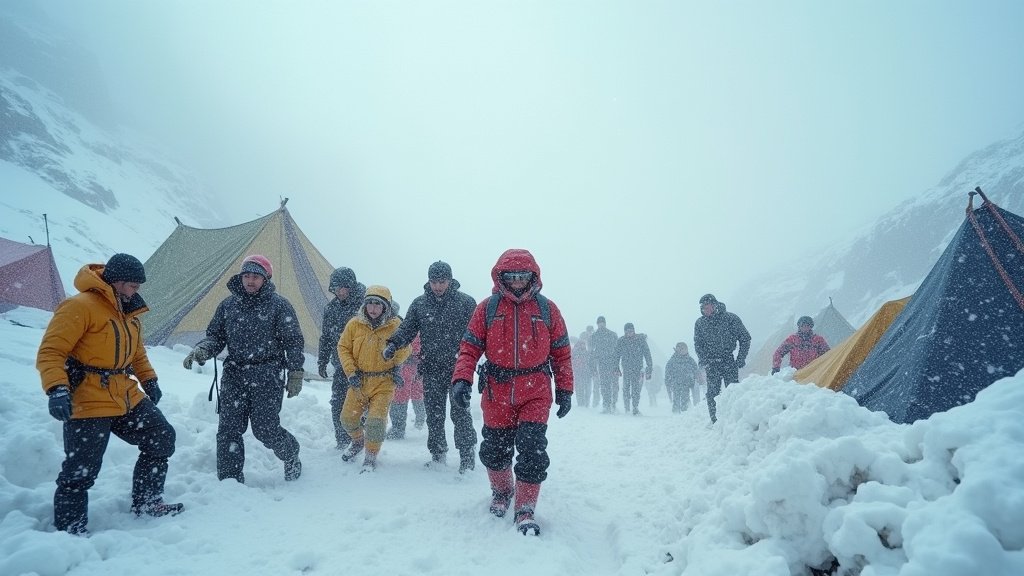SHANGHAI – A severe blizzard has trapped nearly 1,000 people, including climbers and tourists, on the Tibetan side of Mount Everest, prompting urgent rescue operations. The intense snowfall began Friday evening, October 3, 2025, and continued relentlessly through Saturday, October 4, effectively cutting off access to campsites and popular routes on the mountain’s eastern slope. This unfolding situation has become a trending topic, with fears growing for those stranded at altitudes exceeding 4,900 meters (16,000 feet).
Blizzard Unleashes Fury on Everest’s Tibetan Slope
The heavy snowfall and high winds created treacherous conditions, leading to blocked roads and impassable access points to the Everest Scenic Area. Chinese state media reports confirmed that hundreds of local villagers and dedicated rescue teams have been mobilized to clear the snow and restore access. Initial reports indicate that some of the stranded individuals may be suffering from hypothermia, underscoring the critical nature of the ongoing rescue efforts.
Rescue Efforts Mobilized Amidst Extreme Conditions
Rescue teams, bolstered by hundreds of local villagers, are working against the clock to reach the stranded individuals and clear pathways to the affected campsites. While some tourists have reportedly been evacuated, the sheer number of people trapped necessitates a large-scale and coordinated response. The primary focus is on ensuring the safety and well-being of everyone caught in the storm’s path, battling sub-zero temperatures and limited visibility.
Access Restricted: Everest Scenic Area Closed
In response to the extreme weather and to facilitate rescue operations, authorities have suspended ticket sales and entry to the Everest Scenic Area. Notices posted on the official WeChat accounts of the Tingri County Tourism Company confirmed the closure from late Saturday, October 4, indicating the severity of the situation and the government’s immediate actions to manage the crisis.
A Wider Himalayan Weather Crisis
These perilous happenings on the Tibetan side of Everest occur concurrently with devastating weather events on the Nepal side of the mountain and across the wider Himalayan region. Heavy rains have triggered widespread landslides and flash floods in Nepal, resulting in at least 47 confirmed deaths and numerous missing persons. Thirty-five fatalities were reported in the Ilam district alone, with others lost to floodwaters and lightning strikes. This dual-hemisphere weather emergency highlights the precariousness of life in the high-altitude regions and the unpredictable nature of the current monsoon season’s aftermath.
The Precarious Nature of Everest Expeditions
Mount Everest, known for its extreme climate, presents significant challenges even during established climbing seasons. While the autumn season, typically from late September to early November, offers fewer crowds than the spring, it is also subject to unpredictable weather patterns, including early snowfall and strong winds. The vast, remote terrain and the thin atmosphere mean that sudden storms can rapidly turn dangerous, testing the limits of even the most experienced mountaineers. Chinese authorities have established meteorological stations at various altitudes, including one at over 8,800 meters, to support scientific research and provide crucial weather data for climbers.
Looking Ahead
As rescue teams continue their arduous work on the Tibetan slope, the focus remains on safely extricating all those trapped by the blizzard. The concurrent disasters in Nepal serve as a stark reminder of the powerful forces of nature that shape life and travel in the Himalayas. The full extent of the impact and the success of the rescue missions will unfold in the coming days, with authorities closely monitoring the situation and coordinating relief efforts.





